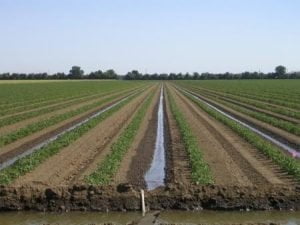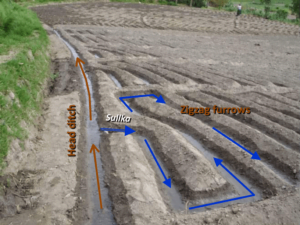Table of Contents
1. Introduction
Furrow Irrigation is an excellent method of irrigation for row crops like potato, cauliflower, cabbage, maize, sunflower, sugarcane, soybean, citrus, grape, etc.
Several furrows are constructed for facilitating irrigation, so this irrigation is named furrow irrigation.
What are furrows?

Furrows are the series of long narrow channels constructed in the field.
Furrows vary from 8 to 30 cm deep and maybe as much as 400 meters long. Width may be chosen based on the crop type. Commonly, the width of furrows is taken 5 to 10 times the depth.
Excessive long furrows lead to excessive percolation at the upper end and too little water near the downslope end.
Deep furrows are widely used for row crops. Small shallow furrows called corrugations are particularly suited for meadows and small grains.
Crops are usually planted on the top or sides of ridges or furrows. Water applied in the field gets soaked into the soil & spreads into the Root Zone.
What are the types of furrows?
We will discuss commonly used 3 types of furrows. They are:
a. Straight furrows
When the furrows are constructed along the straight lines (i.e. lines that are parallel to the field boundary), then such furrows are said straight furrows.
These furrows are commonly constructed when the land to be irrigated is plain.

b. Contour furrows
Those furrows that are constructed along contour lines are contour furrows.
These furrows are commonly utilized in hilly areas.

c. Zigzag furrows
These furrows are suitable when the land to be irrigated is plain.
They are generally constructed in a zigzag manner.
2. Suitability of Furrow Irrigation
Furrow irrigation is suitable in the following:
~ In the relatively flat ground.
~ In flat land furrows are straight but in the sloping ground, furrows are constructed in the contour line.
3. Furrow Irrigation Planning
The main goal of furrow irrigation is to apply the right amount of water as uniformly as possible to meet the crop needs, minimize runoff and deep percolation, and nitrogen leaching below the root zone.
While planning the furrow irrigation in the area we should need to know the following things:
A. How fast water advances down the furrow
B. Soil texture and level of compaction
C. Length of furrow
D. Furrow spacing
A. How fast water advances down the furrow
It refers to the advance time. Here, the time required for water to flow through one end to another end is recorded simultaneously.
B. Soil texture and level of compaction
For sandy soils, the furrow is constructed deep and narrow because water moves faster vertically than sideways. Sandy soils may reduce irrigation efficiency due to their unstable nature and sometimes tends to collapse. Sometimes double-ridged furrows can also be used for sandy soils.
For clayey soils, the furrow is constructed shallow and wide due to its lower infiltration rate and more lateral movement of water.
As compaction restricts water movement in the soil, so less water is required in the compacted soils.
C. Length of furrow
Furrow length is determined on the basis of the impact of the following factors:
i. Slope:
For a steeper land slope, the furrow is longer.
The maximum slope for furrows is 0.5% to avoid erosion.
The minimum slope for furrow is adopted at 0.05% for effective drainage.
The slope should not exceed 3% in any case because this results in soil erosion.
ii. Soil type:
Sandy soil has high infiltration so, the furrow should be short.
Clayey soil has low infiltration so, the furrow should be longer.
iii. Stream size:
For stream size up to 0.5 l/sec, furrows are not too long.
For larger stream sizes, furrows can be longer to avoid soil erosion.
iv. Cultivation practice:
A shorter furrow is applicable for frequent cultivation.
Long furrow facilitates the work when farming is mechanized.
v. Field length:
Furrow length should be equal to the length of the field and must fit the field boundaries.
Ideal length results in a small piece of land left over.
D. Furrow spacing:
Furrow space is planned based on the soil type and the cultivation practice.
Sandy soil requires spacing between 30 and 60 cm. i.e. 30cm for coarse sand and 60 cm for fine sand.
Clayey soil requires spacing between 75 and 150 cm.
4. Furrow construction
Furrow is constructed with the help of the ridger.
A. Construction of furrows on flat or mildly sloping land:
It involves the following steps:

a. Drawing the furrows:
Lines are marked in the field with the help of ranging poles or with chalk powder.
b. Ridging:
Now, along the marked line ridger is moved straightly. If not straight then the field should be plowed again.
c. Equal distancing:
New straight lines should be set out at about every 5 m distance.
Four furrows can be drawn simultaneously if a ridger-drawbar connected with a tractor is used.
Note:
Ridger is a primary soil tillage machine that is commonly connected with tractors and utilized for making ridges.
If the area to be irrigated is small then ridges can be made manually.
B. Construction of a furrow on sloping or undulating land

It requires special care while constructing. It involves the following steps:
a. Firstly, guide the furrow along the upper edge of the field close to the farm channel and is set out using a leveling device to locate the contour line.
b. Further on undulating ground, guide furrows are set out at every 5 meters and on uniformly sloping land at every 10 meters.
c. Furrows are made halfway along the next guide furrow.
5. Maintenance of furrows
a. Weeds should be removed from the field channels and drains.
b. Regular inspection should be done whether water reaches the downstream end of the furrows or not.
c. Avoid the places where water stays ponding.
d. Ridges should not be overtopped.
e. Consistency of furrow slope should be maintained.
6. Pros of Furrow Irrigation
Some pros of this irrigation technique are:
1. Water efficiency is high.
2. Cheap to construct & maintain.
3. Evaporation loss is small.
4. Furrows also serve as drainage.
5. Less wastage of land to make a furrow.
6. Only one-fifth to one-half of the land is wetted by the water.
7. Permits cultivation sooner after irrigation.
8. Less loss due to percolation.
7. Cons of Furrow Irrigation
Some cons of this irrigation technique are:
1. Furrow-making skills are required.
2. Silts from furrows should be regularly removed.
3. Possibility of increased salinity between furrows.
4. Loss of water at the downstream end unless end dykes are used,
5. The necessity of one extra tillage work, VIZ, furrow construction.
6. Possibility of increased erosion, and
7. Furrow irrigation requires more labor than any other surface irrigation method.
Thank You!
| Read Also: Drip Irrigation |


